Message Archiver
Connecting to Unity Connection 7.x or Later
Task
2: Set the Database Proxy Service Shutdown Time
Task
3: Activate the Remote Database Proxy Service
Task
4: For Connection 12.0 and Later Enable Secure IMAP
Task
5: Login to the Remote Server
Troubleshooting Remote Login Issues
Double
Check Connection Server Settings
Disable
CSA and all Virus Scanning Applications
Make
sure the Informix .NET Driver is Installed and the PATH Points to it.
Using Message Archiver with Unrestricted
Versions of Connection
Note
about Secure Messages with CUMI
Using Message Archiver for Non-Voice
Messages
Archive
all Voice Messages for a Particular Subscriber between a Time Range
Overview
The Message Archiver tool is designed
to do one thing: fetch messages for selected users and save them locally as EML
files. This is most often used by
administrators when monitoring an inbox or needing to save off a copy of a
particular message for legal reasons or the like. The Message Archiver is a read-only tool, it
makes no updates to any message states, cannot delete messages etc. Tool is also allows you to archive all voice
messages into an ordinary zip file or a password protected zip file. If you
need a tool for that the Message Archiver application may be what you're
looking for.
Requirements/Special Notes
This
version of Message Archiver runs on Windows XP/2000/2003/2008, Vista or Windows
7.
You
must install the 32 bit Informix Client SDK version 3.5 or later including the
.NET drivers even if you are running on a 64 bit version of your operating
system. See the Informix Driver Download Page for details.
You
must enable the ODBC proxy service on the any Unity Connection servers you want
to archive messages from.
This
tool uses Microsoft’s full .NET 4.0 library (the limited “client” version of
.NET 4.0 is not sufficient). The
installation will check to see if you have that installed and if not will offer
you the option to download and install it automatically.
Connecting to Unity
Connection 7.x or Later
For
installations of 7.x and later you need to use the database proxy service for
access to the database from off box for any DB tool including Message Archiver.
Task 1: Configure a User
with the Remote Administrator, Mailbox Access Delegate Account and System
Administrator roles
1. Go
to the Cisco Unity Connection Administration web interface for your installation.
2. You
can leverage a user with or without a mailbox for off box data access purposes,
but it’s strongly
suggested that you create a new user without a mailbox that is used solely for
the purpose of remote administration tasks for security reasons. This is also required if you want to export
messages from a Connection 7.0(2) or later server – a user with a mailbox may
not be allowed to extract messages from other mailboxes, whereas a user without
a mailbox should have no problem.
3. Be
sure the web administration password for this user is not configured to require
a change at first login on the “Password Policy” page for that user.
4. If
necessary, change the web administration password on the “Change Password”
page. Note that only the web application
password comes into play for remote data access.
5. For Unity Connection Server 7.x only:
Finally, on the “Role” page for the user, add the “Remote Administrator” and the “System
Administrator” roles to the “Assigned Roles” list and save.
For Unity Connection Server 8.x and
later: On the “Role” page for the user, add the
“Remote Administrator”, “Mailbox Access Delegate Account” and
the “System Administrator” roles to
the “Assigned Roles” list and save.
You
can assign any or all other roles as well but for the purposes of remote access
to the database and making updates to users those two are necessary.
NOTE:
For Unity Connection server 8.x and
later: If you just want to view the voice message and do not want to archive
them, in that case you need not to add the “Mailbox Access Delegate Account” role. “Mailbox Access Delegate Account” role
is only required when you want to archive voice messages for a subscriber on
the Cisco Unity Connection 8.x and later.
Task
2: Set the Database Proxy Service Shutdown Time
For
systems running Unity Connection 10.0 and later this step is not necessary.
Out
of the box the database proxy service is not running and if you try to start
the service it will shut down right away.
First you need to set the “Database Proxy: Service Shutdown Timer” value
found in the System Settings -> Advanced -> Connection Administration
section of the Cisco Unity Connection Administration page. By default this is 0. You can set it to as high as 999 days if you
like. After the number of days
configured here the remote database proxy service will shut down. This is useful if you want to do some
migration work, for instance, and don’t want to forget to have the service
disabled for security reasons.
NOTE: If you restart the server, the remote database proxy
service will remain shut off. After a
system restart you have to go in and manually turn on the service again (see
step 3)
Task 3: Activate the Remote Database Proxy Service
1. Out
of the box the service that listens to remote database requests is not active,
you must turn it on. To do this, go to
the “Cisco Unity Connection Serviceability” web admin page.
2. On
the Tools menu, select the “Service Management” page.
3. The
“Connection Database Proxy” item under the “Optional Services” section will be
marked as “Deactivated” and stopped.
Press the “Activate” button and it will be activated and started
automatically.
Once
you’ve started the proxy service you can connect with any tool that needs off
box database access using the user name, web administration password and port
“20532”.
NOTE: The service will automatically shut down after the number of
days configured in step 2 above or if you restart the server.
Task 4: For Connection 12.0 and Later Enable
Secure IMAP
Connection 12.0 and later ships with secure IMAP connections
turned off by default. For message
extraction in 12.0 and later you must:
1.
Attach the server to a licensing service. You cannot turn on secure protocols for a
server that is not licensed – as such you cannot extract messages via IMAP
until you’ve licensed the server.
2.
From the Unity Connection CLI logged in as an
administrator you need to run the command “utils cuc encryption enable”. Once this is
done successfully the secure IMAP connection used by COBRAS and other tools
will be enabled.
Task 5: Login to the Remote Server
When you first start Message Archiver, you will see a login
dialog box that will be empty except for port 20532 filled in as the default
for the port. You must provide the server name or IP address for the “Server”
field and provide the login and password for the database connection
account. Use the alias and web
administration password of the database user created above for the login and
password fields.
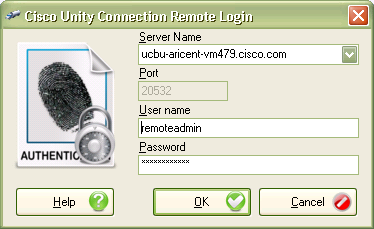
Message Archiver will remember your entries including the
password (which is stored in a secure hash).
Each time you run Message Archiver it will load the settings of the last
connection you made. Every server you’ve
successfully connected to in the past will be listed in the drop down list in
the order in which you connected to it last – most recent to least recent.
NOTE:
The login and password information is
stored along with the local Windows login name.
Only those servers that have been attached to successfully using the
current Windows login will be listed. If
you are logging into the same Windows server with different users you will only
see servers connected to with that particular Windows login.
NOTE:
Providing the wrong password or login
will fail quickly and give you a chance to try a different pair. Providing an incorrect server or port,
however, results in a 60 second timeout while MESSAGE ARCHIVER waits for the
Informix driver to return. Unfortunately
this cannot be shorted. Type carefully.
Troubleshooting Remote
Login Issues
Double Check Connection Server Settings
Make sure the remote database proxy
service is running. This service does
shut itself off after a period of time and does not start itself automatically
on a server reboot.
Make sure the user you are logged in as
has the remote administrator role assigned to their account, that their
password is not set to reset at the next login and that their account is not
currently locked.
Make sure the server name or IP address
you are using to connect with is reachable from your Windows client. DNS issues often come up in connection
failures.
Disable CSA and all
Virus Scanning Applications
It’s a good idea to disable CSA and all
virus scanning applications if you are having problems connecting to be sure
the ODBC port (20532) is not being blocked.
Also check your firewall settings (assuming you are running one).
Make sure the Informix
.NET Driver is Installed and the PATH Points to it.
For 32 bit OS installs, the IBM
Informix driver is installed in C:\Program
Files\IBM\Informix\Client-SDK. Make
sure this path exists on your server and has not been removed or renamed.
The system PATH variable will also
include a reference to the “\IBM\Informix\Client-SDK\bin”
location where the driver is installed.
Make sure this path is referenced in the PATH. Also, if the PATH is very long sometimes the
Informix driver will not find it, try moving it to the beginning of the PATH
statement.
If you had an older version of the IBM
Informix Client SDK installed it's a good idea to uninstall all other versions
and make sure you have a single instance of the SDK 3.5 or later. Mixing versions of Informix drivers is not a
good idea as only one can be active at a time.
Make Sure Firewalls are not Blocking
Ports:
Two ports are used by Message
Archiver: 7993 for secure IMAP (for extracting messages) and 20532 for the ODBC connection. These are the only two ports used – HTTP, HTTP2,
SMTP etc… are not needed or used by the application.
Using Message Archiver
with Unrestricted Versions of Connection
Unrestricted versions of Unity Connection do not allow for secure IMAP connections by design – unrestricted means the version can ship all over the world including areas that ban forms of encryption necessary to support secure IMAP and super-user mail access. By default the Message Archiver tool uses secure IMAP to fetch messages and, as such, if you’re running it against an unrestricted version of Connection you can see the messages but when you go to download them the fetch will fail since the secure IMAP login will be denied.
To get around this there is a command line option that will instead download messages using the HTTP REST based CUMI API. This works only for 8.0 versions of Connection and later and requires you run the tool with the “/UseCUMI” command line option to be active. If you are running an unrestricted install prior to version 8.0 you cannot fetch messages, only see the subjects and details. You will have to upgrade to 8.0 or later to leverage this functionality.
Both CUMI and IMAP require the “Mailbox Access Delegate Account“ role for the user you log in with to fetch messages and both use ODBC for fetching message data, finding users etc… only the actual message content fetch is done using IMAP or CUMI.
Note about Secure Messages with CUMI
By default CUMI does not allow messages marked secure to be downloaded. You will see an error message when secure messages are downloaded when using /UseCUMI command line option if you don’t configure the server to allow for this. Assuming you want to include secure messages in your archive request, make sure the option for “Allow Access to Secure Message Recordings through CUMI” is checked in the Advanced Settings | API Settings section in the Unity Connection administration interface:
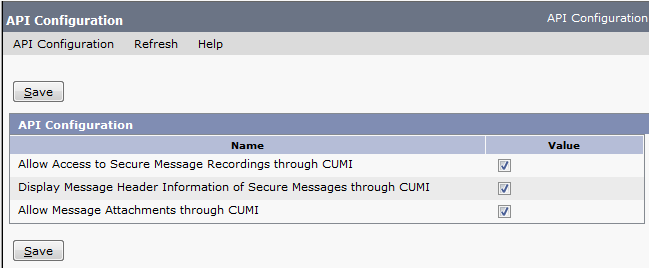
Note that by default the secure messages option is off and the “Allow Message Attachments through CUMI” is turned on – you’ll want to be sure BOTH are enabled if you want secure messages to be downloadable via the message archiver (or when exporting with COBRAS for that matter).
Using Message Archiver
for Non-Voice Messages
Message Archiver allows administrator to view as well as archive non-voice messages like Email, Delivery Receipt message (DR), Non-Delivery Receipt message (NDR), Read Receipt Message (RR) etc. For archiving non-voice messages you have to check “Archive Non-Voice Message” under the ‘Option’ button by default it will remain uncheck so whenever you need view or archive non-voice messages you have to check. After this you can load all non-voice messages by hitting ‘Load Message’ button and also you can archive non-voice messages by hitting ‘Archive’ button.
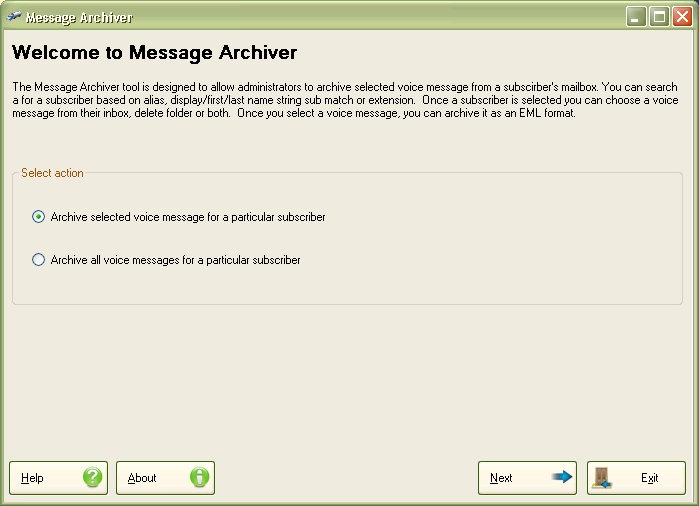
Note: Message Arhiver does not provide support for archiving non-voice messages using /useCUMI command line option. You can only archive non-voice messages using IMAP.
Using Message Archiver
Welcome to Message Archiver
The Message Archiver is a simple wizard
interface. Once you log into the Connection server you want to pull messages from
via ODBC, the first page provide you following options:
Select Action:
·
Archive selected voice message for a
particular subscriber: This option allows you to archive one or more
voice messages for a selected subscriber at a time.
· Archive all voice messages for a particular subscriber: This option allows you to archive all voice messages (including inbox and deleted items only) for a selected subscriber.
· Archive all voice messages for a particular subscriber between a time zone: This option allows you to archive all voice messages for a selected subscriber between a specified time ranges.
· View all voice messages for a particular subscriber: This option allows you to view all voice messages (including inbox, draft and deleted items only) for a selected subscriber.
Select Zip Type:
· Archive all voice messages into an ordinary zip file: Set this option to archive all voice messages (currently available under the subscriber’ message folder on local system) for a subscriber into a simple zip file.
·
Archive all voice messages into a secure zip
file: Set this option, if you want to archive all voice messages
(currently available under the subscriber’ message folder on local system) for
a subscriber into a password protected zip file. For secure zipping, you must select
this option and provide a password used to encrypt the messages into a zip
file. You will have to provide this password at the time of unzipping. If you
forget this password those messages cannot be recovered, they are lost to you.
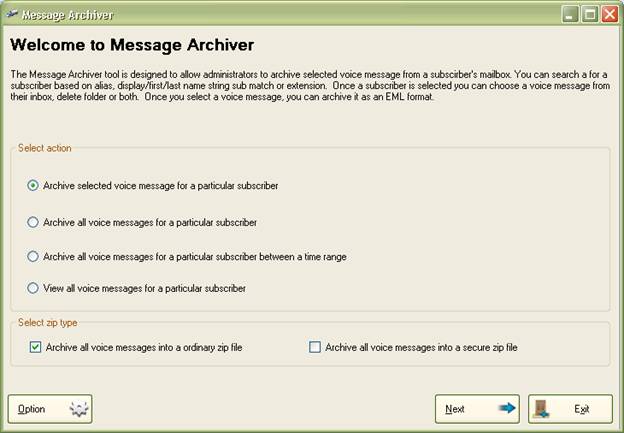
Select Subscriber
Once you’ve selected an option to
“Archive selected voice message for a particular subscriber” you can move to
second wizard i.e. Select a Subscriber. This will
allows you to search and select a subscriber that homed on that Connection
server.
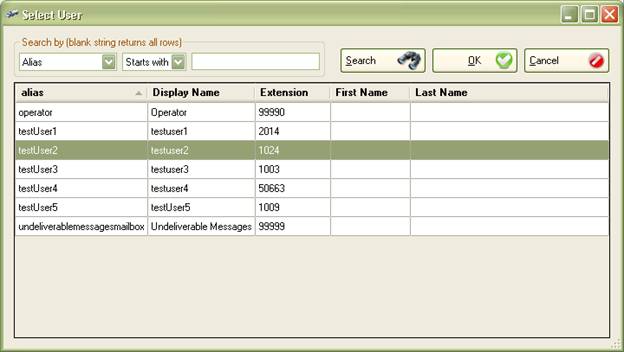
The select subscriber dialog is pretty
straight forward - you can choose a subscriber based on their extension, alias,
first name or last name using a "starts with", "contains"
or "is exactly" type query. If
you leave the text box blank it will fetch all subscribers.
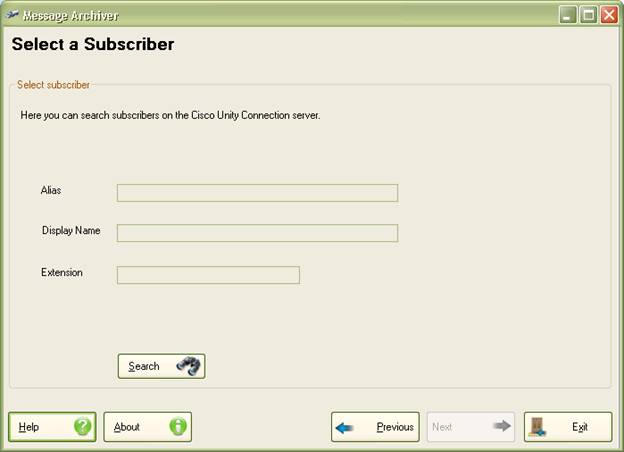
Once you've selected a subscriber you
can hit the "Next" button
Select Messages
Once you've selected a subscriber you
can move to the Select a Message to Archive page. You can load messages from the inbox folder,
the deleted folder or both.
Note: Deleted messages will only be saved to the
deleted items folder if the subscriber’s class of service is configured to
allow that. Note that saved messages do
not include binary attachment, only routing information so there's no option for
archiving sent messages here.
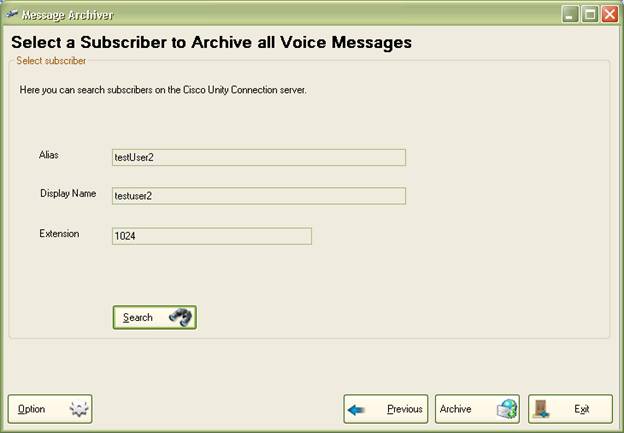
To archive a message simply select it and either double
click on that row or press the "Archive" button at the bottom of the
form. The message will be archived into
a sub folder using the selected subscriber's alias and all messages selected
for that user to be archived will appear in that sub folder using the date/time
of the message along with a unique message ID to form the file name of the EML
file. This allows you to select as many
messages for as many subscribers as you like in a session and easily be able to
sort them out later.
The folder for message archival is in the
"Messages" folder under the installation directory you chose for the
Message Archiver tool.
Archive all Voice Messages
When you’ve selected an option to “Archive all voice
messages for a particular subscriber” from the welcome page, the second wizard
that appears in front of you is Select a Subscriber to Archive all Voice Messages.
This wizard will allow you to archive all voice messages for a selected
subscriber. Here you need to select a subscriber same as above and click on
“Archive” button at the bottom of the form.
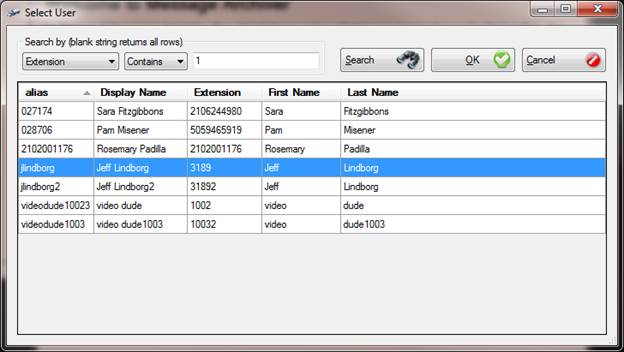
Archive all Voice Messages for a Particular Subscriber
between a Time Range
When you’ve selected an option to “Archive all voice
messages for a particular subscriber between a time range” from the welcome
page, the second wizard that appears in front of you is Select a Subscriber to
Archive all Voice Messages between a time range. This wizard will allow you to
archive all voice messages for a selected subscriber under a specified time range.
Here you need to select a subscriber first same as above than you have to
select a start date and end date. Once you specified the time range you have to
click on “Archive” button at the bottom of the form.
View all Voice Messages
Once you've selected a subscriber you
can move to the View all Voice Messages page. You can load messages from the
inbox folder, the deleted folder or both or from the draft folder.
Note: You can view deleted messages if the
subscriber’s class of service is configured to save deleted messages into the
deleted items folder.
Note:
By default draft message are not saved on the Cisco Unity Connection. If
selected subscriber has the configuration to save voice messages as draft
messages then only you can view draft messages here. Another thing related to
draft messages is, you cannot archive draft message.
Password for Secure Zipping
This wizard will appear in front of you when you’ve selected
an option to “Archive all voice messages into a secure zip file” from the
welcome page under selection zip type option. Here you need to provide a
password that will be used to encrypt all voice messages for a subscriber into
a secure zip file.
Note: Please remember this password as you will have to provide
this password at the time of unzipping. If you forget this password those
messages cannot be recovered, they are lost to you.
Obtaining Updates
To check for updates to this tool, visit http://www.CiscoUnityTools.com
Revision History
Version 1.0.15 – 11/10/2016
· Updated to .NET 4.5
· Updated HTTP connections for CUMI to handle forcing SSL3 connections when attaching to Unity Connection servers older than 10.0
Version 1.0.14 – 1/1/2016
· Updated for Windows 10 deployments
Version 1.0.13 – 3/18/2015
· Updated SQLite libraries
· Updated setup to include all modern Windows versions as targets.
Version 1.0.12 – 9/4/2014
· Added support to fetch non-voice messages from Unity Connection.
Version 1.0.11 – 4/4/2014
· Added “/UseCUMI” command line option to fetch message content using the REST based CUMI API instead of the default secure IMAP path which is not available for unrestricted installations of Unity Connection.
Version 1.0.10 – 12/5/2013
· Updated logic to allow administrator to archive voice messages form Unity Connection server 7.x. as ‘Mailbox Access Delegate Account’ role does not exists on Unity Connection server 7.x.
Version 1.0.9 – 10/24/2013
· Updated logic to validate ‘Mailbox Access Delegate Account’ role for Unity Connection 8.0.
Version 1.0.8 – 7/23/2013
· Added message duration column to the voice messages view grid.
· Added logic to sort messages in grid by read, urgent or secure columns.
· Added logic to show forwarded messages in to the voice message view grid.
· Added a new message filter option to show draft messages in to the voice message view grid on “View all Voice Message” page.
· Added logic to allow archiving of messages as an EML file only if the login user has the “Mailbox Access Delegate Account” role.
· Added new option on welcome page to view all voice messages for a particular subscriber.
Version 1.0.7 – 5/15/2013
· Added debug output option.
Version
1.0.6 – 5/2/2013
· Added logic for simple zipping and password protected zipping.
Version
1.0.5 – 4/29/2013
· Added logic to archive all voice messages for a subscriber between a time range
Version
1.0.4 – 4/26/2013
· Added logic to archive all voice messages for a selected subscriber.
Version
1.0.3 – 4/23/2013
· Added logic to archive more than one voice message for a selected subscriber at a time.
Version
1.0.2 – 4/18/2013
· Fixed an error where the splash screen would not dismiss on a login failure scenario.
Version
1.0.1 – 4/16/2013
· First drop of beta tool.
© 2014 Cisco Systems, Inc. -- Company Confidential